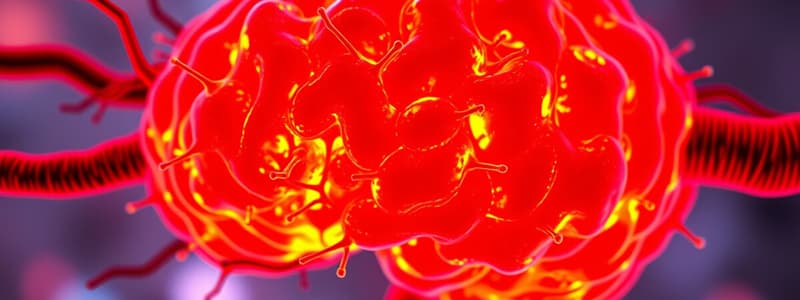Podcast
Questions and Answers
What are the types of postsynaptic potentials?
What are the types of postsynaptic potentials?
- Excitatory (EPSP)
- Inhibitory (IPSP)
- Both A and B (correct)
- None of the above
What does EPSP stand for?
What does EPSP stand for?
Excitatory Postsynaptic Potential
What does IPSP stand for?
What does IPSP stand for?
Inhibitory Postsynaptic Potential
What occurs after an action potential travels down an axon?
What occurs after an action potential travels down an axon?
What are the summation types for EPSP and IPSP?
What are the summation types for EPSP and IPSP?
What is Spatial Summation?
What is Spatial Summation?
What is Temporal Summation?
What is Temporal Summation?
What happens during the Absolute Refractory Period?
What happens during the Absolute Refractory Period?
What is the first chemical event at the synapse?
What is the first chemical event at the synapse?
What happens during re-uptake?
What happens during re-uptake?
What is an Autoreceptor?
What is an Autoreceptor?
What is a Presynaptic Receptor?
What is a Presynaptic Receptor?
What characterizes an Axoaxonic Synapse?
What characterizes an Axoaxonic Synapse?
What occurs during Postsynaptic Inhibition?
What occurs during Postsynaptic Inhibition?
What is the effect of Ionotropic neurotransmitter action?
What is the effect of Ionotropic neurotransmitter action?
What defines Metabotropic neurotransmitter action?
What defines Metabotropic neurotransmitter action?
Flashcards are hidden until you start studying
Study Notes
Types of Postsynaptic Potentials
- Two main types: Excitatory Postsynaptic Potential (EPSP) and Inhibitory Postsynaptic Potential (IPSP).
Excitatory Postsynaptic Potential (EPSP)
- EPSP leads to the depolarization of the postsynaptic membrane.
- It moves the neuron closer to firing an action potential.
- Occurs when negatively charged ions exit and positively charged ions enter the cell.
Inhibitory Postsynaptic Potential (IPSP)
- IPSP results in hyperpolarization of the postsynaptic membrane.
- It moves the neuron farther away from firing an action potential.
- Occurs when more negatively charged ions are added to a negatively charged receptor cell.
Postsynaptic Potential
- Characterizes the change in the postsynaptic cell's electrical state after neurotransmitter release following an action potential.
EPSP and IPSP Properties
- Both types travel from their site of generation as graded potentials.
- They exhibit cable properties allowing them to influence the postsynaptic neuron.
Axon Hillock
- The location where EPSP and IPSP are summed.
- Determines if the threshold for an action potential is reached through various summation methods.
EPSP/IPSP Summation Types
- Types include spatial summation and temporal summation, which describe how signals combine at the axon hillock.
Spatial Summation
- Occurs when multiple EPSPs and IPSPs from different sites converge at the axon hillock simultaneously.
Temporal Summation
- Involves EPSPs and IPSPs arriving at the axon hillock in quick succession, allowing them to cumulatively influence the membrane potential.
Absolute Refractory Period
- Characterizes the state when Na+ channels are activated and can’t respond to further stimuli.
Chemical Events at the Synapse
- Sequence of events critical for neuron communication across the synapse.
First Chemical Event
- The synthesis of neurotransmitters by the neuron.
Second Chemical Event
- Storage or transport of neurotransmitters within axon terminals.
Third Chemical Event
- An action potential triggers neurotransmitter release into the synaptic cleft.
Fourth Chemical Event
- Neurotransmitters travel across the synaptic cleft and bind to receptors on the postsynaptic membrane.
Fifth Chemical Event
- Neurotransmitters detach from receptors; this process is controlled and time-limited.
Sixth Chemical Event
- Neurotransmitters are either taken back into the presynaptic neuron, diffuse away, or become inactivated, a process known as "re-uptake."
Seventh Chemical Event (Optional)
- Postsynaptic cells may send feedback to slow neurotransmitter release, preventing excessive excitation.
Ionotropic Receptors
- Directly activate and open ion channels, leading to immediate changes in the postsynaptic cell.
Metabotropic Receptors
- Engage in a multistep process that results in the postsynaptic cell's depolarization or hyperpolarization.
Modulation of Neurotransmitter Release
- Mechanisms include autoreceptors, presynaptic receptors, axoaxonic synapses, and postsynaptic inhibition.
Autoreceptors
- Receptors sensitive to the neuron's own neurotransmitter that provide feedback to regulate release.
Presynaptic Receptors
- Receptors that respond to different neurotransmitters than their own.
Axoaxonic Synapse
- Modulates presynaptic activity through the release of different neurotransmitters, leading to inhibition or facilitation.
Postsynaptic Inhibition
- Mechanism where chemicals from a neuron travel back to the presynaptic terminal to reduce the release of its neurotransmitters.
Studying That Suits You
Use AI to generate personalized quizzes and flashcards to suit your learning preferences.



